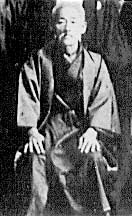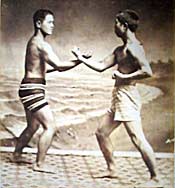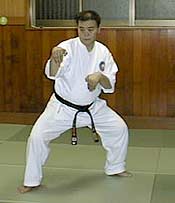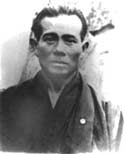Unraveling The Mysteries Of The Nafadi Tradition: Its
Kata
By Joe Swift
Editor's Introduction
As early 20th century karate emerged from centuries
of secret practice on Okinawa, what was practiced was a far cry from the
karate we know today. There were no styles, no organizations, uniforms,
ranks or syllabuses -- only a few dedicated enthusiasts passing on the
unnamed techniques they had learned. Some referred to their art in a generic
sense as "Te"(or "di") meaning hand, Okinawan Te,
Tode (Chinese hand) or by other names.
Many practitioners lived in the most populated southern
end of Okinawa within three principal Okinawan towns, and what they practiced
in technique and had many distinct characteristics. This led to early
classifications of karate by some, based on geographic area, and terms
that referred to the towns within which they lived -- Naha, Shuri and
Tomari.
Shuri was the capital city, seat of government (now
an Okinwan prefecture), former nobles and landed gentry who had lost their
status, and site of the famous Shuri Castle once occupied by a secession
of kings. Situated high atop a hill, Shuri was served by a small nearby
seaport town of Tomari. Nearby too, was Naha, Okinawa's principal seaport
and commercial center -- an international town bustling with ships and
seamen and traders from many nations. Located closely by, and later swallowed
up by Naha as it grew, was the Chinese village of Kume, a principal center
for Chinese immigrants, teachers and merchants, and home to various Chinese
martial arts exponents.
The fighting traditions of Naha (Kume) developed into
one of the two major continuing traditions of early Okinawan karate that
became known as Naha-te, or Nafadi ( meaning "Naha hand" in
English. "Di" was the Okinawan word for hand and "te"
was the same word put pronounced slightly differently in mainland Japanese).
The "Original" Nafadi Curriculum
While the term Nafadi (Naha-te in standard Japanese) was not officially
used until late 1926, it has since become accepted to mean any of the
modern styles to have descended from the Chinese boxing once practiced
in Naha and in its "Chinatown" of Kume Village. This includes,
but is by no means limited to, Goju ryu, Uchi-ryu and To'on-ryu (styles
of karate).
This series of articles shall explore the roots of the kata commonly
accepted as Nafadi traditions through historical records and contemporary
research. Additionally, rare historical photographs shall be included,
and selected applications for each kata described.
What exactly did the original Nafadi curriculum consist of? Unfortunately,
a conclusive answer to this question may never be determined. However,
we can make some educated guesses based upon the evidence and data that
we do have, such as the kata practiced within this tradition.
 |
Higaonna Kanryo |
First of all, the record of the San Ru Chu celebration (1)
(that marked the formal severance of political ties between China and
the Ryukyus since the islands were about to be officially absorbed into
the Japan nation) (2) tells us, without
a doubt, that there was a version of the karate kata Seisan and Pechurin/Suparinpei
that were performed in 1867. Kanryo Higaonna (the great Naha karate pioneer
and teacher of Miyagi who founded Goju-Ryu karate) was a mere lad of 14
or 15 at that time, long before he ever traveled to Fujian (to pursue
his martial arts studies), the Chinese coastal province nearest Okinawa
by sea (an area often visited by Okinawan students seeking further education
in the fighting arts). Although we may never know exactly what "versions"
of these kata were performed, for the sake of this article we shall assume
that they were the precursors to those practiced in the modern karate
styles of Goju-ryu, Shito-ryu, and Toon-ryu.
 |
Miyagi Chojun and Kyoda Juhatsu
practicing a two-person drill |
Second, we can compare the kata curricula of Higaonna's two most prolific
students: Chojun Miyagi, founder of the Nahadi karate style Goju-ryu that
is today one of the world's most popular practiced styles, and Juhatsu
Kyoda, who was one of the first to publicly teach karate at Okinawan Prefectual
Middle School. Although Kyoda never developed a large direct student following,
he did teach a small group of serious students in what became known as
Toon-ryu (To'on-ryu). He was a highly respected Okinawan karate-ka and
was influential in the development of many leading karate-ka. He was known
for his teaching of the kata sanseiru. In 1934 he was named Chief of the
Okinawan branch of the Butokukai (Short for Dai Nippon Butokukai, or Great
Japan Martial Virtues Association founded in 1895 to preserve and promote
the martial arts and ways).
Chojun Miyagi's Goju-Ryu Karate-do Kata Curriculum
(note: the name following the kata refers to the possible
source of the kata):
Sanchin - Kanryo Higaonna
Seisan - Kanryo Higaonna
Sanseiru - Kanryo Higaonna (3)
Suparinpei/Pechurin - Kanryo Higaonna
Saifa - Kanryo Higaonna (?)
Seiunchin - Kanryo Higaonna (?)
Shisochin - Kanryo Higaonna (?)
Seipai - Kanryo Higaona (?)
Kururunfa - Kanryo Higaonna (?)
Gekisai 1 & 2 - Miyagi Chojun
Tensho - Miyagi Chojun
Juhatsu Kyoda's Toon-ryu Karate-do Kata Curriculum (note: the name following
the kata refers to the possible source of the kata):
Sanchin - Kanryo Higaonna
Seisan - Kanryo Higaonna and Kanyu Higaonna
Sanseiru - Kanryo Higaonna
Pechurin - Kanryo Higaonna
Jion - Kentsu Yabu
Nepai - Go Kenki
From the above, we can see that only the first four kata, i.e. Sanchin,
Seisan, Sanseiru and Suparinpei/Pechurin, appear in both curricula. Whereas
Kyoda's other two kata (Jion and Nepai) are clearly identified as to their
source, the remaining kata of Miyagi are assumed to be from Higaonna,
although there is no clear evidence of their source. However, with the
historical record described above, as well as using some simple comparative
analysis with regard to the kata, we can make some deductions.
The testimony of other direct students of Higaonna, such as Chogi Yoshimura,
Higaonna's first student, provides glimpses into the origination of these
kata. Yoshimura tells us that he learned Sanchin and Pechurin under the
master (Higaonna). A complete translation of this record will be presented
later in this article series. Ura Soki also stated in an interview with
prominent Goju-ryu and Tomari-ti teacher Tokashiki Iken (the karate master
and historian), that "Higaonna only ever taught three or four kata.
Modern Goju-ryu has too many kata." Ura himself apparently specialized
in Sanchin and Seisan.
In addition, a technical analysis of the various Goju-ryu kata tells
us a lot. We can immediately discern that the four kata common between
Miyagi and Kyoda's curricula are indeed from a common source. Some of
the major features that distinguish these kata from the others are listed
below.
1 - All start with the typical Sanchin (kata) sequence of middle level
blocks and reverse punches while in a pigeon toe stance.
2 - Sanchin and Seisan kata end in the posture known as Tora-guchi
(a.k.a. Mawashi-uke, a two hand roundhouse block or technique), whereas
the kata Sanseiru and Pechurin/Suparinpei end in the double crane beak
posture.
3 - All are asymmetrical with regard to the major techniques, meaning
that although the signature techniques are performed in all directions,
they are all performed only with the right side of the body.
 |
 |
Sanchin kata stance
with block and arm pulled back in preperation for punch |
Mawashi-Uke
Block |
 |
Double Crane Beak Posture |
By contrast, the remaining Goju-ryu kata all seem to exhibit dissimilar
characteristics, thus suggesting that they do not have a common source.
For example:
1- Although Shisochin kata begins with the familiar Sanchin sequence,
albeit with open hands (4) it is symmetrical
in that the major techniques are performed with both the left and the
right sides of the body.
2- Although Saifa and Kururunfa kata both end with tora-guchi, they
lack the Sanchin sequence, and the major techniques are performed on
both sides of the body.
3- Although the remaining Goju-ryu kata are all symmetrical, with regard
to the use of both the left and right sides of the body for the major
signature techniques, they all seem to be unrelated to each other with
regard to their major characteristics.
The Uechi-ryu Connection
 |
Kanbun Uechi |
Let us now turn our attention to another Nahadi system, Uechi-ryu karate.
The style is based on the technique and kata learned in China by the
style's founder Kanbun Uechi, but it appears to have kata in common with
other Nahadi styles emanating from the Higaonna tradition (who also traveled
to China to study in Fujan).
It is commonly believed that Uechi learned some form of Tiger Boxing,
probably with elements of Crane Boxing, from the famed Zhou Zi He in Fuzhou.
However, looking at the three kata that Kanbun Uechi is said to have brought
back from his time studying in China with Zhou Zi He, we see the names
Sanchin, Seisan and Sanseiru (kata). Interestingly enough, oral tradition
in Uechi-ryu karate circles states that in the original Quanfa style (Chinese
fighting art) that Kanbun Uechi studied, there was also a kata called
Pechurin or Suparinpei, but Uechi never learned this form.
In addition, there is more than just similarity in some kata names between
Uechi-ryu and Goju-ryu and Toon-Ryu. There are also similarities in how
some kata are performed. The Uechi-ryu Sanchin kata, although performed
with open hands, is highly reminiscent of the Higaonna version. Indeed,
oral tradition maintains that Higaonna originally taught Sanchin with
open hands. The first half of the Uechi-ryu Seisan kata is also suspiciously
similar to the Higaonna version. Although more research is necessary to
determine what this actually means, it is entirely possible that Uechi
was exposed to the classical Nafadi tradition through his studies at the
Kogusuku Dojo in Fuzhou (Hirakami, 2001).
Afterthought
In closing, there is one very important point that should be considered:
What is the source of the additional Nafadi kata as embraced by modern
Goju-ryu and Shito-ryu? Although beyond the scope of this article, this
point is presented here as food for thought and a topic for future research.
If indeed the original curriculum of Nafadi consisted only of Sanchin,
Seisan, Sanseiru and Pechurin/Suparinpei, then from where did the remaining
kata used in modern Gojuryu come? Noted Japanese martial arts researcher
Hirakami Nobuyuki suggests three possibilities:
1- They were brought to Okinawa from Fuzhou by Kanryo Higaonna.
2- They were ancient kata passed down in Naha from days of old.
3- They were added by Chojun Miyagi from alternative sources.
If we take Goju-ryu's "creation legend" (that kata were passed
down to Miyagi from his teacher Higaonna) at face value, then of course
we will get possibility #1 (above) as the true history. If we look for
evidence for possibility #2 as we saw above, the kata Shisochin may have
been demonstrated alongside Seisan and Suparinpei as early as 1867. And
finally, with regard to possibility # 3, it is interesting to note that
in the pre-war books on karate, none of the other Goju-ryu kata seem to
have been mentioned in writing prior to 1934, with the exception of Seienchin
(5) and possibly Shisochin.
Unsure what all of this means, this author, and others, continue to search
for key pieces of the puzzle. Unfortunately, however, most of these pieces
have either been horribly twisted out of shape by those who would force
them to fit with the other pieces in a hurried attempt to complete the
picture, or have been lost behind the sofas and under the carpets of history,
like a jigsaw whose box has been carelessly kicked around the room.
The next installment of this series shall take a look at Sanchin kata,
which has long been regarded as the most fundamental element of the Nafadi
styles.
Acknowledgment:
The author would like to thank Christopher Caile, FightingArts.Com
Editor-In-Chief, for his Introduction, editing and the many clarifications
made within the text and footnotes.
Footnotes:
(1) San Ru Chu celebration refers to the 1867
celebration in front of the last Sappushi (also called Sakuhosi, or Sapposhi).
Sappushi were Chinese Imperial Envoys of the Ming Dynasty, often accompanied
by a huge entourage of occupational specialists, tradesman and guards
(sometimes 400-500 in total) who visited Okinawa for a number of months.
Sappushi carried dispatches and returned to China with reports, and members
of the visiting group often instructed members of Okinawaís ruling
class on a variety of subjects.
"The very last Sappushi to visit Ryukyu, Zhao Xin,
stayed for a total of five months, between 1866 and 1867 (Sakagami, 1978).
In April 1867, a celebration was held that marked the formal severance
of political ties between the two ancient nations. This celebration was
called San-Ru-Chu Narabini Shogei Bangumi or the "Show of 3-6-9 and
the Arts," and featured not only various performing arts, but also
demonstrations of the local Chinese-based fighting traditions which would
later become known the world over as karate-do and Ryukyu kobudo. Please
see Patrick McCarthy's writings for a complete translation of the contents
of the martial arts portion of this demonstration (McCarthy, 1999). Although
not related to the martial arts, it is also nonetheless interesting to
note that a certain Peichin Kogusuku performed on the Biwa (a kind of
Japanese lute) and read poetry at the same celebration."
(2) Early Okinawa (pre-1300s) was largely influenced
by Japan in language and culture and to a lesser extent by Korea early
on. Okinawa and other islands in Ryukyu Island chain also share a common
linguistic heritage. There are also records of Japanese immigration southward
along the Ryukyu island chain starting just off the coast of Kyushu (Japan's
southernmost island), including Japanese Samurai seeking political refuge
(especially from 12th century and later). But, beginning in the 14th century
(based on greater sea going capability and the rise of trade) Okinawa
established a tributary allegiance with China in return for trade rights
and recognition by China of the Okinawan government headed by a succession
of kings. Okinawan society also adopted many Chinese cultural and political
traditions, Chinese characters (writing), and the educated class was schooled
in Chinese classics. Thus, the original Okinawan Japanese influenced culture
assumed many Chinese trappings, although evidence suggests that Chinese
immigrants often kept to their own cultural groupings such as the community
near Naha, known as Kume village. This community was established in 1393
when China sent what is known as the "36 Families" to Okinawa
(36 is a term used to denote "many"). Kume village was used
as an arrival point for Chinese diplomats and envoys and a center of Chinese
culture and learning. But the southern Japanese Satsuma Clan also had
historic claims to the islands and in 1609 invaded the Ryukyus and took
control. Interestingly, however, Okinawa was forced to maintain its status
with China so as not to interfere with trade (Okinawa serving as a trade
outlet for the Satsuma at a time when Japan was sealed from other international
activity). This produced a somewhat schizophrenic situation, since when
Chinese envoys or officials were present (visiting) all traces of Satsuma
control pulled back out of sight. This status continued until the Ryukyus
were formally annexed to Japan in 1879.
(3) According to some sources, Miyagi did not
learn Sanseiru directly from Higaonna, as he was on his mandatory military
duty while this kata was being taught. Juhatsu Kyoda has been quoted as
saying that he was the only one who learned Higaonna's Sanseiru. Although
it is likely that Miyagi did indeed learn this kata direct from Higaonna,
other possible sources for this kata include his trips to China, or later
cross training with his brother disciples under Higaonna.
(4) It should be noted that this is how Sanchin
kata is believed to have been practiced before Higaonna changed the kata
to a closed fist. Shisochin shall be discussed in more detail later in
this series.
(5) Choki Motobu mentioned Seienchin in his 1926
and 1932 publications.
Bibliography
Bishop, M. (1999) Okinawan Karate: Teachers, Styles and
Secret Techniques, 2nd Edition. Boston: Charles E. Tuttle Co., Ltd.
Funakoshi G. (1922) Ryukyu Kenpo Karate. Tokyo: Bukyosha.
Gima S. and Fujiwara R. (1986) Taidan Kindai Karatedo
no Rekishi wo Kataru. Tokyo: Baseball Magazine.
Higaonna M. (1996) The History of Karate: Gojuryu. California:
Dragon Books.
Hirakami N, (2001) ìKoden Ryukyu Kenpo: Naha-te
no Himitsu,î Gekkan Hiden, Issue 1/2001 through 10/2001. Tokyo:
BAB Japan.
Hokama T. (2001a) Karatedo Rekishi Nenpyo. Naha: Okinawa
Tosho Center.
Hokama T. (2001b) Okinawa Karate Retsuden Hyakunin. Nishihara:
Privately Published.
Iwai T. (1992) Koden Ryukyu Karatejutsu. Tokyo: Airyudo.
Iwai K. (2000) Motobu Choki to Ryukyu Karate. Tokyo:
Airyudo.
Kinjo A. (1999) Karate Den Shinroku: Denrai-shi to Genryu
Kata. Naha: Okinawa Tosho Center.
Mabuni K. and Nakasone G. (1938) Kobu Kenpo Karatedo
Nyumon. Tokyo: Kobukan.
McCarthy, P. (1995) Bubishi: The Bible of Karate. Tokyo:
Charles E. Tuttle Co., Inc.
McCarthy, P. (1999) Ancient Okinawan Martial Arts: Koryu
Uchinadi (Volume 2). Boston: Charles E. Tuttle Co., Inc.
McKenna, M. (2001) ìExploring Goju Ryuís
Past: Myths and Facts Surounding Higashionna Kanryo, pt. 1-2.î Dragon
Times. Vol. 18-19.
Nagamine S. (1986) Shijitsu to Kuden ni Yoru Okinawa
no Karate Sumo Meijin Den. Tokyo: Shin Jinbutsu Oraisha.
Sakagami R. (1978) Karatedo Kata Taikan. Tokyo: Nichibosha.
Tokashiki I. (1987) Okinawa Gohakukai Karatedo: 20-Nen
no Ayumi. Naha: Gohakukai.
Tokashiki I. (1988) Gohaku Nenkanshi Vol. 2. Naha: Gohakukai.
Tokashiki I. (1989) Gohaku Nenkanshi Vol. 3. Naha: Gohakukai.
Tokashiki I. (1991) Gohaku Nenkanshi Vol. 4. Naha: Gohakukai.
Uechi K., ed. (1978) Seisetsu Okinawa Karatedo: Sono
Rekishi to Giho. Naha: Uechiryu Karatedo Kyokai.
Historical Photographs:
Higaonna Kanryo and students, courtesy of Iwai Tsukuo.
Miyagi Chojun and Kyoda Juhatsu practicing a two-person
drill, courtesy of Kanzaki Shigekazu.
Uechi Kanbun, courtesy of Mario McKenna.
Mawashi-uke and Sanchin Photos courtacy of Masters Publications
and Christopher Caile.
About The Author:
Joe Swift, native of New York State (USA), has lived in Japan since
1994. He has worked as a professional translator/ interpreter, and previously
served as an assistant instructor at the Mushinkan Okinawa Karate Kobudo
Dojo in Kanazawa. Swift now resides in Tokyo and will be opening a branch
of the Mushinkan Dojo (Okinawa Shoreiryu) in that city. A well known
karate historian and researcher, Swift has published articles in the
Dragon Times and other leading martial arts journals and on a variety
of martial arts websites around the world. He is a Contributing Editor
for FightingArts.com.
|